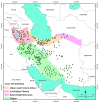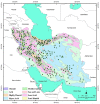Diversity and Distribution Patterns of Endemic Medicinal and Aromatic Plants of Iran: Implications for Conservation and Habitat Management
- PMID: 35162573
- PMCID: PMC8835522
- DOI: 10.3390/ijerph19031552
Diversity and Distribution Patterns of Endemic Medicinal and Aromatic Plants of Iran: Implications for Conservation and Habitat Management
Abstract
Iran, with its unique climatic and topographic conditions, is home to about 8200 species of vascular plants. Approximately 2300 of the 8200 species are popularly characterized as medicinal or aromatic. Here, we compile information about the endemic medicinal and aromatic plants (MAPs) of Iran and map their distributions. Our survey found 180 endemic species of MAPs, belonging to 10 families and 30 genera. The majority of species are found in Lamiaceae, Fabaceae, and Apiaceae, with 86, 30, and 18 species, respectively. Approximately 70% of these plants have been recorded in the 10 provinces of Esfahan, Kerman, Fars, Tehran, Chaharmahal va Bakhtiari, East Azarbaijan, Lorestan, West Azarbaijan, Hamadan, and Mazandaran. These provinces are located in the Iran-o-Turanian region, one of the three major phytogeographic regions in Iran, which covers five areas of endemism (i.e., Azarbaijan, Zagros, Kopet Dagh-Khorassan, Alborz, and Central Alborz). So, Iran-o-Turanian region is the main center of diversity for the Iranian endemic MAPs. The north, center and western parts of Iran are rich in MAPs and could be considered as the dominant biodiversity hotspots of Iran more seemingly due to the diverse climatic and geographic assortment which generates the highest frequency and distribution of MAPs. Many of these MAPs are at the edge of extinction due to the unwise, unscientific harvesting and/or global climate change. Therefore, there is an urgent need to conserve and propagate some of these important MAPs to save them from extinction and also to ensure the availability of raw materials for their use and future research into their efficacy. Furthermore, identifying the areas of endemism (AEs) is an essential part of ongoing regional conservation management programs in Iran and worldwide.
Keywords: Irano-Anatolian Hotspot; biodiversity hotspots (BHs); conservation; endemism; extinction; medicinal and aromatic plants (MAPs).
Conflict of interest statement
The authors declare that they have no conflict of interest.
Figures








Similar articles
-
Endemic cushions of the Khorassan-Kopet Dagh floristic province show differential responses to future climate change.Sci Rep. 2025 May 8;15(1):16046. doi: 10.1038/s41598-025-00453-0. Sci Rep. 2025. PMID: 40341424 Free PMC article.
-
Endemic diversity and distribution of the Iranian vascular flora across phytogeographical regions, biodiversity hotspots and areas of endemism.Sci Rep. 2019 Sep 10;9(1):12991. doi: 10.1038/s41598-019-49417-1. Sci Rep. 2019. PMID: 31506504 Free PMC article.
-
The influence of climate change on the suitable habitats of Allium species endemic to Iran.Environ Monit Assess. 2022 Feb 11;194(3):169. doi: 10.1007/s10661-022-09793-0. Environ Monit Assess. 2022. PMID: 35146574
-
Endemism hotspots are linked to stable climatic refugia.Ann Bot. 2017 Jan;119(2):207-214. doi: 10.1093/aob/mcw248. Epub 2017 Jan 7. Ann Bot. 2017. PMID: 28064195 Free PMC article. Review.
-
Visions of the past and dreams of the future in the Orient: the Irano-Turanian region from classical botany to evolutionary studies.Biol Rev Camb Philos Soc. 2017 Aug;92(3):1365-1388. doi: 10.1111/brv.12287. Epub 2016 Jun 28. Biol Rev Camb Philos Soc. 2017. PMID: 27349491 Review.
Cited by
-
The amount of antioxidants in honey has a strong relationship with the plants selected by honey bees.Sci Rep. 2024 Jan 3;14(1):351. doi: 10.1038/s41598-023-51099-9. Sci Rep. 2024. PMID: 38172229 Free PMC article.
-
Prevalence, patterns, and disclosure of complementary and alternative medicine (CAM) use among patients with thyroid diseases: A cross-sectional study in Iran.Heliyon. 2024 Jun 22;10(13):e33436. doi: 10.1016/j.heliyon.2024.e33436. eCollection 2024 Jul 15. Heliyon. 2024. PMID: 39040366 Free PMC article.
-
Edible Herbal Medicines as an Alternative to Common Medication for Sleep Disorders: A Review Article.Curr Neuropharmacol. 2024;22(7):1205-1232. doi: 10.2174/1570159X21666230621143944. Curr Neuropharmacol. 2024. PMID: 37345244 Free PMC article. Review.
-
Fabrication of Carum copticum essential oil-loaded chitosan nanoparticles and evaluation its insecticidal activity for controlling Rhyzopertha dominica and Tribolium confusum.Front Plant Sci. 2023 Jul 28;14:1187616. doi: 10.3389/fpls.2023.1187616. eCollection 2023. Front Plant Sci. 2023. PMID: 37575925 Free PMC article.
-
In vitro micropropagation and conservation of endangered medicinal plant Nepeta asterotricha Rech.f. (Lamiaceae): genetic fidelity, phytochemical and biological assessment.Physiol Mol Biol Plants. 2024 Jan;30(1):67-80. doi: 10.1007/s12298-024-01416-x. Epub 2024 Feb 23. Physiol Mol Biol Plants. 2024. PMID: 38435858 Free PMC article.
References
-
- Noroozi J., Talebi A., Doostmohammadi M., Manafzadeh S., Asgarpour Z., Schneeweiss G. Endemic diversity and distribution of the Iranian vascular flora across phytogeographical regions, biodiversity hotspots and areas of endemism. Sci. Rep. 2019;9:12991. doi: 10.1038/s41598-019-49417-1. - DOI - PMC - PubMed
-
- Hrdina A., Romportl D. Evaluating global biodiversity hotspots—Very rich and even more endangered. J. Landsc. Ecol. 2017;10:108–115. doi: 10.1515/jlecol-2017-0013. - DOI
-
- Gonçalves-Souza D., Verburg P.H., Dobrovolski R. Habitat loss, extinction predictability and conservation efforts in the terrestrial ecoregions. Biol. Conserv. 2020;246:108579. doi: 10.1016/j.biocon.2020.108579. - DOI
-
- Hobohm C., Janišová M., Steinbauer M., Landi S., Field R., Vanderplank S., Beierkuhnlein C., Grytnes J.-A., Vetaas O.R., Fidelis A., et al. Global endemics-area relationships of vascular plants. Perspect. Ecol. Conserv. 2019;17:41–49. doi: 10.1016/j.pecon.2019.04.002. - DOI
Publication types
MeSH terms
LinkOut - more resources
Full Text Sources

